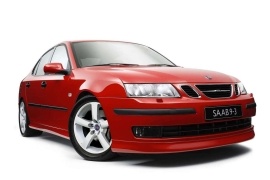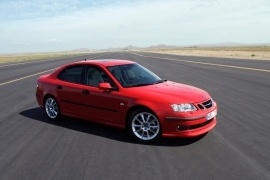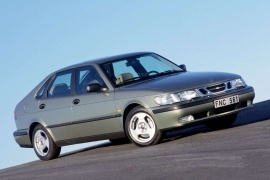SAAB 9-3 Sport Sedan Models/Series Timeline, Specifications & Photos
First production year: 1998
Engines: Gasoline, Ethanol, Diesel
Saab had to evolve to meet the Euro5 emission standards, so seven years after the 9-3's introduction, it came with an improved version at the Geneva Motor Show.
While the Swedish carmaker desperately tried to stay alive, in GM's headquarters, the decision was already made to get rid of their troublemaker premium European brand. For instance, while GM ordered Saab's officials to make badge-engineered Opel/Vauxhall Vectras, the people from Trollhattam (Saab's HQ) decided to change the car here and there and made it better. But that led to higher costs in both the development and production. Consequently, the sales stalled. On top of that, Europe was in pain due to the world financial crisis of the late '2000s.
From the outside, the car sported a refreshed front fascia, with the introduction of a new bumper that featured side-scoops for cooling the brakes and an A-shaped lower grille. The upper grille was split in three, with the center one with the chromed Saab badge in the middle of a transverse chromed slat. There was not even a single panel that looked like it could fit on any of its siblings. Even the door handles were different. At the back, the carmaker installed clear lenses over the taillights, creating a sportier appearance.
Inside, the dashboard was typical Saab, with the center stack tilted towards the driver. The bucket seats at the front offered small side support for the base trim level, while the top-spec version received high-bolstered seats.
Under the hood, Saab installed a vast engine range. It also made the 9-3 available with front or all-wheel drive.
SAAB 9-3 Sport Sedan 1.8i 5MT (122 HP)
SAAB 9-3 Sport Sedan 1.8t 5AT (150 HP)
SAAB 9-3 Sport Sedan 1.8t 6MT (150 HP)
SAAB 9-3 Sport Sedan 2.0L V6 Turbo 6AT XWD (280 HP)
SAAB 9-3 Sport Sedan 2.0t 5AT (175 HP)
SAAB 9-3 Sport Sedan 2.0T 5AT (210 HP)
SAAB 9-3 Sport Sedan 2.0t 6MT (175 HP)
SAAB 9-3 Sport Sedan 2.0T 6MT (210 HP)
SAAB 9-3 Sport Sedan 2.8L V6 Turbo 6AT (280 HP)
In 2008, Saab unveiled the Turbo X as the ultimate performance version for the 9-3 range and the top-performer model for the Swedish carmaker family.
While the world economic crisis started to take its toll among the carmakers, Saab struggled to survive. Its cars were already too expensive for the market, and its sales plunged. The carmaker needed a desperate move and charged with a unique version of the 9-3 range: the Turbo X. It showed up late, in the autumn of 2007, exactly three decades after the unveiling of the 900 Turbo, at the Frankfurt Motor Show, in two body versions: sedan and station wagon.
Its look was distinctive compared to the rest of the range. First of all, it was available only in metallic jet black, with the front grille and all exterior detailing accented in a matte gray titanium-like finish. It represented an updated interpretation of the 900 Turbo, the first turbocharged production vehicle sold by Saab. Unlike the rest of the 9-3 range, the Turbo X featured different front and rear bumpers, with silver adornments around the fog lights and rear diffuser. From its sides, the 18” light-alloy wheels sported a unique design.
Inside, the 9-3 Turbo X featured an instrument panel with three large dials. The speedometer took the center stage flanked by the tachometer on the left and a specific dial on the right, which showed a turbo-gauge like the 900 Turbo, the fuel level, and the coolant temperature.
Under the skin, the carmaker installed a turbocharged V-6 engine paired with a six-speed manual, which sent the power in all corners via an intelligent all-wheel-drive system. That distributed the torque between the front and rear axles and the left and right rear wheels thanks to an electronically controlled limited-slip differential.
Saab launched the 2003 9-3 lineup while it was under GM's management, and it was supposed to be the premium version of the mundane Opel/Vauxhall Vectra.
General Motors was eager to get a cut from the European premium car market and thought Saab would be its best bet. Thus, it ordered the Swedish carmaker to produce a re-badged Opel/Vauxhall Vectra slightly adapted. Thus, it should lower the manufacturing costs but still be able to get into the premium segment. But Saab took things differently.
The Swedish management considered that they had a duty in front of its customers and reshaped the car. Even though the 9-3 relied on the same platform as its Vectra sibling, it had a completely different shape. With the Sport Sedan version, it took things even further. Its angular headlights and the lower apron made to protect pedestrians in the event of a crash gave the car an aggressive look but not scary. Moreover, unlike its predecessors, the 9-3 was no longer available as a fastback.
Inside, Saab installed its own buttons and switches. Even the infotainment unit was different than the one offered by GM. It was better but more expensive, which made the American carmaker's officials angry. Also, unlike other carmakers, Saab had a signature feature on the inside, where the key-fob was placed between the front seats, not on the steering column or on the dash.
Under the hood, the Sports Sedan offered a choice of four-cylinder engines ranging between 122 and 210 PS (120 – 207 HP) paired with either manual or automatic transmissions.
SAAB 9-3 Sport Sedan 1.8L 5AT FWD (150 HP)
SAAB 9-3 Sport Sedan 1.8L 5MT FWD (122 HP)
SAAB 9-3 Sport Sedan 1.8L 5MT FWD (150 HP)
SAAB 9-3 Sport Sedan 2.0L 5AT FWD (175 HP)
SAAB 9-3 Sport Sedan 2.0L 5MT FWD (175 HP)
SAAB 9-3 Sport Sedan 2.0L TS 5AT FWD (210 HP)
Saab was under the GM umbrella when it introduced the second generation of the 9-3 range as a compact sedan with a sporty and premium character.
General Motors desperately tried to make the Swedish brand profitable because they were bleeding money. For that, they granted them the platform from a Vauxhall/Opel Vectra and Cadillac BLS, telling them to build a car on top of that, but with minimal changes. Saab considered that the platform was too weak to meet its safety standards. In the end, the 9-3 shared only 30% of the parts with other GM vehicles.
From the outside, there was a specific design. Saab shared didn't share any body panel with its siblings. Its headlights sported an angular design with a Saab-specific grille between them. Also, the wrapped-around bumper featured an apron extended forward. In a collision with a pedestrian, that design lifts the person above the car, not underneath. Later on, that measure was implemented and mandatory on most European vehicles, but Saab did it in 2002.
Inside, Saab didn't take any switch or button from the GM parts bin. Not even the infotainment unit. Saab did a better job for that, but more expensive. Its key-fob mounted between the front seats was a signature feature for the Swedish brand. The center stack formed together with the instrument panel a surrounding area for the driver. For the Aero trim level, the sport bucket-seats with high bolstering were standard.
Under the hood, Saab installed a unique turbocharged 2.8-liter engine. Later on, Opel/Vauxhall carried that over on the Insignia OPC/VXR. But when Saab introduced it, it was too expensive for the market. It sent its power to the front wheels via a six-speed gearbox, either manual or automatic.
The 1998 Saab 9-3 was an evolution over the previous 900 series, especially regarding design, but a completely new vehicle from the platform point of view, which was a “cousin” of the European Opel Vectra. The unusual look of the car, with a sloped rear, was a Saab brand signature.
Inside the vehicle, some of the aviation-inspired features were kept and some others were added. For instance, the ignition key was placed between the front seats, next to the handbrake. The dashboard had a “night” mode, where only the speedometer was illuminated during the night to decrease the effort for the driver. The Swedish engineers worked hard to offer a Swedish car even if underneath it was a GM platform.
The engines were mainly 2.0-liters with outputs ranging between 130 and 205 hp. Only the base version was naturally aspirated. The 150hp, 154hp, 185hp and 205hp are all turbocharged. The top-performer is called “Viggen” (Thunderbolt) and borrowed its name from the Saab Viggen fighter-jet.
Saab introduced low-pressure turbochargers to increase the torque at low revs and decrease fuel consumption. The transmissions offered on the 9-3 were either a 5-speed manual or a 4-speed automatic. The 9-3 Viggen had a 0-100 kph (0-62 mph) sprint in 6.4 seconds and a top speed of 249 kph (154.9 mph).
It worth mentioning that Saab 9-3 was the first car in the world to receive a 5 star EuroNCAP rating at the European crash-tests.
SAAB 9-3 2.0L 4AT FWD (130 HP)
SAAB 9-3 2.0L 4AT FWD (150 HP)
SAAB 9-3 2.0L 4AT FWD (154 HP)
SAAB 9-3 2.0L 5MT FWD (130 HP)
SAAB 9-3 2.0L 5MT FWD (150 HP)
SAAB 9-3 2.0L 5MT FWD (154 HP)
SAAB 9-3 2.0L Turbo 4AT FWD (185 HP)
SAAB 9-3 2.0L Turbo 4AT FWD (205 HP)
SAAB 9-3 2.0L Turbo 5MT FWD (185 HP)
SAAB 9-3 2.0L Turbo 5MT FWD (200 HP)
SAAB 9-3 2.0L Turbo 5MT FWD (205 HP)
SAAB 9-3 2.3L 4AT FWD (150 HP)




